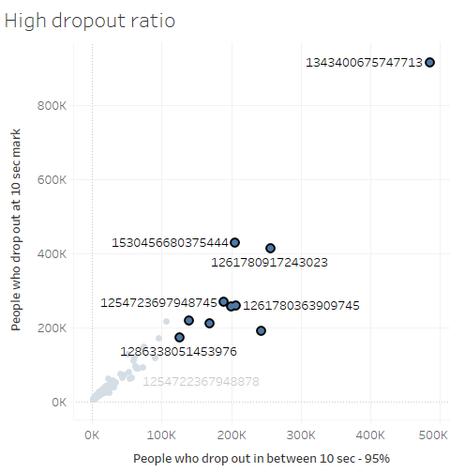|
|
| Line 52: |
Line 52: |
| | <!---------------END of sub menu ----------------------> | | <!---------------END of sub menu ----------------------> |
| | <br> | | <br> |
| − | | + | <center><b><u>Business Objective #2: Which are the Facebook videos that have high dropout rates? </u></b></center> |
| − | <!-------------- Old Content | |
| − | <div align="center">
| |
| − | <div style=" width: 85%; background: #E6EDFA; padding: 12px; font-family: Arimo; font-size: 18px; font-weight: bold; line-height: 1em; text-indent: 15px; border-left: #8c8d94 solid 32px;"><font color="#5A6B96">Data Source</font></div> | |
| − | </div> | |
| − | | |
| − | <div align="left">
| |
| − | <div style=" width: 90%; padding:10px; font-family: Arimo; font-size: 14px; line-height: 1em; text-indent: 30px;">
| |
| | <p> | | <p> |
| − | ::*For data files from <i>Facebook Insights Data Export (Post Level)</i>, the sponsor provided exported data from different periods of the year, with different metric tabs in Excel format. The tabs included are:
| + | Using Facebook Insights Data Export (Video Posts), we extracted the data from the Total Video Performance tab with the aim of identifying the videos with high drop-out ratio. (73 rows in total) |
| − | #Key Metrics
| |
| − | #Lifetime: Number of unique people who have created a story about your Page post by interacting with it (unique users)
| |
| − | #Lifetime: Number of people who have clicked anywhere in your post, by type (unique users)
| |
| − | #Lifetime: Number of people who have given negative feedback on your post, by type (unique users)
| |
| − | | |
| − | ::*Facebook Post data comprises of 4 main types (a total of 1381 rows):
| |
| − | #Link (955 rows)
| |
| − | #Photo (56 rows)
| |
| − | #Shared Video (103 rows)
| |
| − | #Video (267 rows)
| |
| − | </p>
| |
| − | </div>
| |
| − | </div>
| |
| | | | |
| − | <div align="center">
| + | This will assist XYZ with identifying videos with content fatigue problems at a strategic level. High drop-out ratio refers to types of video content that viewers will deviate promptly after viewing the video for the first few seconds. |
| − | <div style=" width: 85%; background: #E6EDFA; padding: 12px; font-family: Arimo; font-size: 18px; font-weight: bold; line-height: 1em; text-indent: 15px; border-left: #8c8d94 solid 32px;"><font color="#5A6B96">Data Preparation</font></div>
| |
| − | </div>
| |
| | | | |
| − | <div align="left">
| + | Using three key metrics namely: (a) Lifetime Total Video views, (b) Lifetime Total 10-sec views and (c) Lifetime total video watches at 95%, we are able to calculate the following two derived columns using JMP Pro (as below): |
| − | <div style="width: 90%;padding:10px; font-family: Arimo; font-size: 14px; line-height: 1em; text-indent: 30px;">
| + | <br/> |
| − | <p>
| + | *Viewers who drop out at 10 sec mark = (a) - (b) |
| − | ::To help us have an overview of the data throughout the year, we consolidated the various tabs, whilst concatenating the various periods of data for the same columns, into one combined file. This was carried out using the software, IBM JMP Pro, in the following steps:
| + | *Viewers who drop out in between 10 sec and 95% mark = (b) - (c) |
| − | ::* With Post ID, Permalink (permanent link of the campaign content), Post Message, Type, Countries and Posted columns as key identifiers among the different tabs for the excel files, we appended desired columns from the other tabs to the end of the Key Metrics. They included the Share, Like, Comment columns from Tab 2; Other Clicks, Link Clicks, Photo View, Video Play columns from Tab 3; Hide_Clicks , Hide_all_clicks, Unlike_page_clicks, report_spam_clicks columns from Tab 4. <br>This was conducted using the <i>Tables > Join </i>function, with “Matching Specification” as the key identifiers and “Output Columns” of the appended desired columns. | + | <br/> |
| − | ::* Next, for each period of data files (appended with new columns) from multiple tabs, we concatenate the data across different time periods to have a full year collection of data.<br>This was conducted using the <i>Tables > Concatenate </i> function, while adding multiple data tables into “Data Tables to be Concatenated”.
| + | From the scatter plot, we can observe the top 10 Videos with high dropout ratio after 10 sec. Most of them are <b>travel videos</b>. |
| − | ::* Finally, we check for <b>missing data</b> in the different columns. For example, under the column Type, we have five different types, namely: Link, Photo, Shared Video, Status and Video. However, in the instances of missing data, we will cross check with the permalink of the campaign post, and check the Type of medium was posted and fill it in accordingly.
| + | <i>(Please refer to any of our team mates for the video's corresponding description).</i> |
| − | ::*Using JMP Pro, we can see that there is a particular post that has garnered higher than usual number of shares versus the lifetime post total reach. We will classify it as an outlier in our analysis. The outlier has higher than normal values with 400,000 total reach.
| |
| − | </p>
| |
| − | <center>
| |
| − | [[Image:Share_vs_Lifetime_Post_Total_Reach.PNG|650px|Identification of outlier from all types of Facebook posts]]
| |
| − | </center> | |
| − | </div>
| |
| − | </div>
| |
| − | | |
| − | <div align="center">
| |
| − | <div style=" width: 85%; background: #E6EDFA; padding: 12px; font-family: Arimo; font-size: 18px; font-weight: bold; line-height: 1em; text-indent: 15px; border-left: #8c8d94 solid 32px;"><font color="#5A6B96">Exploratory Data Analysis</font></div>
| |
| − | </div>
| |
| − | <div align="left">
| |
| − | <div style="width: 90%; padding:10px; font-family: Arimo; font-size: 14px; line-height: 1em; text-indent: 30px;">
| |
| − | <p>
| |
| − | ::Using Tableau for visualization, firstly, we can see that the number of Facebook posts is at the lowest at July (for the months from March to December) with only 4 posts, while there are sudden spikes in posts in April and August.
| |
| − | </p> | |
| − | <center>
| |
| − | [[Image:Facebook_Posts_over_Time.png|650px|From the period of March to December 2017]]
| |
| − | </center>
| |
| − | <p>
| |
| − | ::Secondly, to evaluate the effectiveness of Facebook post, we use <b>three key metrics</b> as evaluation. They are: <i>likes, comments and shares</i>. Across time (in weeks), video’s likes, comments and shares have sharp peaks in October, whereas link type performed well in the month of March with highest number of likes and shares. On the other hand, photos performed well in the months of May to August compared to the rest, with an average 2.5K likes, comments and shares, while links and photos remained relatively constant. The outlier mentioned earlier is excluded - to prevent skewness of data.
| |
| − | </p> | |
| | <center> | | <center> |
| − | [[Image:Metrics_against_time.png|650px|Comparing Likes, Shares and Comments across types]] | + | [[Image:High_dropout_ratio.png|450px]] |
| | </center> | | </center> |
| − | <p>
| |
| − | ::Next, the dataset contains 19 missing data for the number of likes across the different post types, out of 1381 records. The data is excluded for our current analysis. We can see that Thursday’s post generally generates the most number of likes, especially for video type.<b>Video type contributes to the highest number of likes</b> (green shaded area), followed by photo type. <br/><br/>
| |
| | </p> | | </p> |
| − | <center>
| |
| − | [[Image:Weekday_vs_Likes.png|450px|Comparing likes across a week]]
| |
| − | </center>
| |
| − | <br/>
| |
| − | <center>
| |
| − | <p>::It can also be noted that video contributes the most number of likes across the various post types with 49.21%. However, it should be noted that link type has higher percentage of engaged users than video type, accounting more than half (51.56%) of lifetime engaged users. </p>
| |
| − | [[Image:Likes_by_Type.png|300px|Likes by Type (% of total sum of likes) ]]
| |
| − | [[Image:Lifetime_Engaged_Users_by_Type.png|600px|Measuring lifetime engaged users by type in percentage]]
| |
| − | </center>
| |
| − | </div>
| |
| − | </div>
| |
| − | End of Old Content ----------------------->
| |

